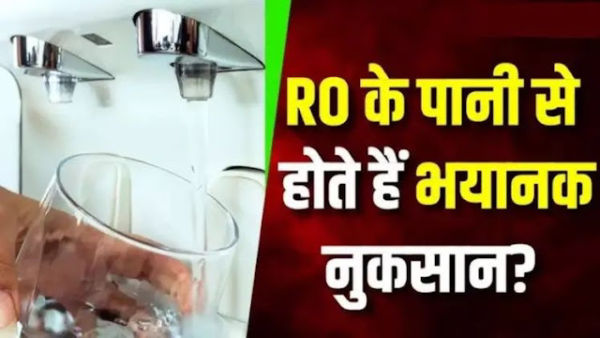
Everyone believes that RO water is the safest. But now the World Health Organization (WHO) and other scientific institutions have revealed a bitter truth, "extremely pure water can become a slow poison for the body."
RO water, in which TDS (total dissolved solids) is extremely low, also cleans the necessary minerals. This can cause electrolyte imbalance in the body, disturbances in metabolism and many long -term diseases. So the question arises that, is the RO technology a boon for our health or is it gradually becoming an invisible threat? Its use is very limited abroad. Let's know how RO water purifiers are harming health, what diseases can cause and what experts recommend on it.
RO Water Purifier: Way of Working
In RO technology, water is passed by a semi-peerable membrane, which removes 90–99% of the solids-TDS-Total Dissolved Solids, minerals, salts and impurities.
RO Water Purifier is Dangerous (Image Credit-Social Media)
But the problem starts from here. Water is not only harmful ingredients, but also removes essential minerals such as calcium, magnesium, potassium and essential micronutrients, which are extremely important for health.
WHO warning: mineral-free water is dangerous
The World Health Organization (WHO) has clarified in its report that, "A minimum of 100 mg/l (mg per liter) in water is necessary for health." WHO says that continuous consumption of low mineral water can cause diseases like electrolyte imbalance in the body, metabolism related problems and weakening of bones.
WHO also clearly wrote in its 2017 and 2020 reports: "Extremely low-mineral content water can have adverse effects on homeostasis mechanisms and bodies mineral balance."
WHO Report: Mineral-Free Water Danger
key points,
- Water with less than 30 mg/l TDS is considered "extremely pure", which is harmful to health.
- Drinking such water continuously can cause lack of calcium and magnesium in the body. WHO has advised countries to keep strict control over the use of RO water purifiers.
RO Water Purifier is Dangerous (Image Credit-Social Media)
Possible diseases caused by RO Water Purifier
1. Mineral Defisance Disorder
Drinking continuous mineral-free water can lead to lack of essential elements like calcium, magnesium, potassium. This can weaken the bones. There is a problem of muscle cramps and fatigue and weakness.
2. Gastrointestinal problems
RO water is extremely clean, which can deteriorate the balance of bacteria required for digestion in the stomach. This can increase problems like indigestion, constipation, abdominal pain.
3. Threat of heart diseases
Many scientific studies have indicated that magnesium deficiency can increase the risk of heart attack and hypertension.
4. Effect on kidney
Electrolyte imbalance leads to additional pressure on the kidney, causing problems related to the kidneys.
5. Skin and hair problems
Lack of essential minerals in the body can cause dry, torn and hair fall.
Experts perspective
RO Water Purifier is Dangerous (Image Credit-Social Media)
Dr. S.K. Panda (Senior Nephrologist, AIIMS New Delhi)
"RO water destroys many minerals required for the body. Regular intake of water without balanced TDS can cause 'Hidden Meinral Defisition' inside the body for a long time. Especially its effects can be more serious in children and the elderly."
Pro. Leonards Van Bruge (WHO, Water Quality Specialist)
"Water should not only be purified to remove impurities; it should be purified by retaining the essential life -giving elements. Very low TDS water, the body's natural mineral is not able to meet the demand."
Status in India: What BIS standard says
The Bureau of Indian Standards (BIS) has recommended TDS up to 500 Mg/L for drinking water, and a minimum of 150 mg/l TDS water is ideal. The RO systems usually maintain TDS between 30 to 50 Mg/L, which is far below the standards of both BIS and WHO. In 2019, the Government of India ordered RO manufacturers to sell RO only when the input water TDS is more than 500 Mg/L.
Rules need for RO water purifier
RO Water Purifier is Dangerous (Image Credit-Social Media)
Experts believe that:
- RO should be used only in areas where water is highly contaminated.
- Otherwise, it is more safe to cleanse the water with the UV (Ultra Violet) or UF (Ultra Filtration) techniques.
- The RO water purifier requires "mineral cartridge" or "TDS controller", so that some essential minerals can be replaced.
What to do? Solutions and suggestions
1. Check TDS level of water
Test the water with TDS meter before applying RO. If TDS is less than 500 mg/l, RO is not needed.
2. Choose Mineral Rich Water
Select the 'Mineral Added RO' system to fulfill the calcium, magnesium required in water.
3. Follow government standards
Pure the water according to the standards specified by BIS and adjust the RO settings.
4. Use natural sources
Where possible, it is more beneficial to boil or filter the natural sources of water like well, waterfall etc.
Is the RO Water Purifier round to end?
- The indiscriminate popularity of RO Water Purifier is now in the dock. The elimination of nutrients required by water in the name of purity can lead to a serious health crisis.
- WHO's warnings and experts' opinions indicate that now the time has come when we should rethink the use of RO water heaters purifiers. It is important that we make it safe and nutritious without destroying the natural properties of water. Because there is no greater agreement with health.
- Mentality regarding the use of RO water purifier abroad
1. Europe (Germany, France, Britain etc.)
According to European Union Drinking Water Directive (EU Directive 2020)
In these countries RO is very rarely in domestic use. Tap tree water is usually drinkable in Europe. Governments already have a strong standard of drinking water. People are confident that their tap water is safe.
The RO is considered as over-purification, which can also be harmful to health, this perception is quite prevalent. RO is used only in certain circumstances (such as contamination of heavy metals), but also take care of remineralization.
2. America
In the US, RO is not as common at the domestic level as in India. Point-of-use filters (such as Carbon Filters, UV Filters) are more popular. RO is mostly used in areas where
There is a risk of arsenic or nitrate in water, or where the Underground Water is used. Both American EPA (Environmental Protection Agency) and CDC (CENTERS For Disease Control) recommend that if the water TDS or mineral level is good, RO has no need if water is good.
Mentality:
"Use RO only if needed, do not spoil normal water unnecessarily with RO."
3. Singapore, Japan, South Korea
Here are high-tech filtration systems use. PUB (Public Utilities Board) in Singapore purifies the tap water so much that you can drink it directly without filters. Remineralization is mandatory where RO -based systems are installed. And there are often smart systems that monitor mineral balance themselves. The mentality of conscious people here is, "Remove the dirt from the water, but don't remove the minerals."
4. Australia and New Zealand
Here too tap water is of very high quality. RO is only in use in areas where water purity in M Borewell or remote areas is low. Governments of these countries recommend that this natural mineral balance of water be maintained.
The main point (briefly):
The quality of tap water is already excellent. Health awareness is high. There people know that the minerals essential with water also go into the body. These governments invest heavy on water treatment, which does not require individual RO purifiers.
The rules there prefer to maintain minerals.
Difference between India and abroad
In many areas in India, there were fluoride, arsenic, TDS in water in many areas, so the trend of RO increased. But now RO is also being used without need in urban areas (where black tap water is also clean), which can become a threat to your health. People in abroad choose the right treatment as per the need, do not put indiscriminate RO.








